Themed collection Postsynthetic modification of coordination networks

Postsynthetic modification of coordination networks
In the last past five years, PSM has grown into an important tool for the manipulation of coordination network materials, and for the preparation of frameworks containing functionalised pores.

CrystEngComm, 2012,14, 4095-4095
https://doi.org/10.1039/C2CE90032G
Discovery, development, and functionalization of Zr(IV)-based metal–organic frameworks
In this Highlight, we review the discovery, development, and functionalization of robust Zr(IV)-based metal–organic frameworks.
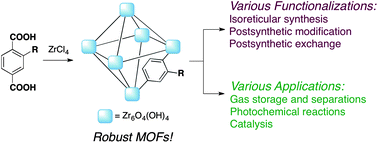
CrystEngComm, 2012,14, 4096-4104
https://doi.org/10.1039/C2CE06491J
Porosity in metal–organic frameworks following thermolytic postsynthetic deprotection: gas sorption , dye uptake and covalent derivatisation
The porosity of MOFs before and after the removal of thermocleavable protecting groups has been probed by a range of experiments.
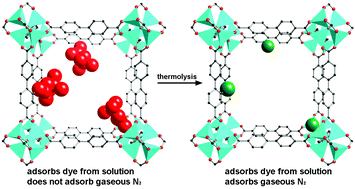
CrystEngComm, 2012,14, 5701-5704
https://doi.org/10.1039/C2CE25854D
Conversion of primary amines into secondary amines on a metal–organic framework using a tandem post-synthetic modification
The amine-functionalised MOF [Zn4O(bdc-NH2)3] (IRMOF-3, bdc-NH2 = 2-amino-1,4-benzenedicarboxylate) has been post-synthetically modified in a tandem condensation-reduction process into secondary amine-containing MOFs. The degree of modification is enhanced by introduction of methanol, which helps to remove boron-containing side-products from the pores.
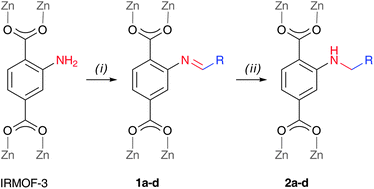
CrystEngComm, 2012,14, 4112-4114
https://doi.org/10.1039/C2CE25131K
Cu-mediated solid-state reaction in a post-functionalized metal–organic framework
A cutting-edge EPR technique allows elucidation of the solid-state self-reactivity of a functionalized MOF containing grafted copper species.
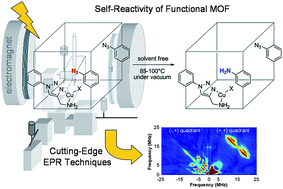
CrystEngComm, 2012,14, 4105-4108
https://doi.org/10.1039/C2CE00017B
A catalytically active vanadyl(catecholate)-decorated metal organic framework via post-synthesis modifications
A catalytically active vanadyl(catecholate)-functionalized MOF was obtained via a sequential pair of post-synthesis modification steps: amine grafting followed by metallation.
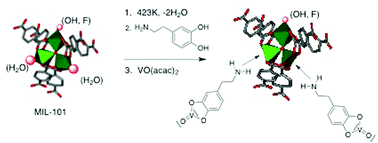
CrystEngComm, 2012,14, 4115-4118
https://doi.org/10.1039/C2CE06666A
Chloromethylation as a functionalisation pathway for metal–organic frameworks
A mild and safe chloromethylation of metal–organic frameworks is presented. After this post-synthetic functionalization, chlorine can be substituted by a wide range of moieties to obtain various multifunctional materials. The method can in principle be extended to coordination polymers with exposed aromatic rings.
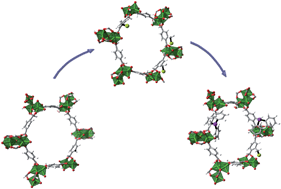
CrystEngComm, 2012,14, 4109-4111
https://doi.org/10.1039/C2CE06594K
Syntheses of metal–organic frameworks with protected phosphonate ligands
Four metal–organic frameworks containing phosphonate were synthesized via same reagent under various solvent and temperature conditions.
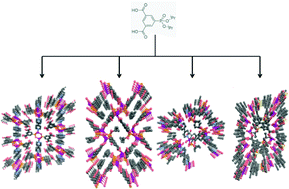
CrystEngComm, 2012,14, 4148-4152
https://doi.org/10.1039/C2CE25358E
Post-synthesis functionalization of MIL-101 using diethylenetriamine : a study on adsorption and catalysis
A catalyst was prepared by grafting triamine to the open metal sites in MIL-101. Its adsorption and catalytic properties after Pd2+ immobilization were evaluated.

CrystEngComm, 2012,14, 4142-4147
https://doi.org/10.1039/C2CE06608D
Conversion of azide to primary amine via Staudinger reaction in metal–organic frameworks
Azide groups in metal–organic frameworks (MOFs) were readily converted into primary amine via Staudinger reduction, which enabled further modification of MOFs with organic dyes bearing activated esters.
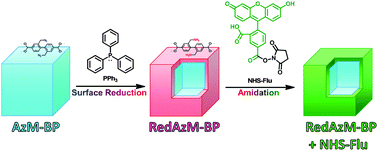
CrystEngComm, 2012,14, 4137-4141
https://doi.org/10.1039/C2CE06633E
Controlled modification of the inorganic and organic bricks in an Al-based MOF by direct and post-synthetic synthesis routes
MW-assisted synthesis and post-synthetic modification allow adjusting the composition and properties of CAU-1 through in situ methylation and de-methoxylation.
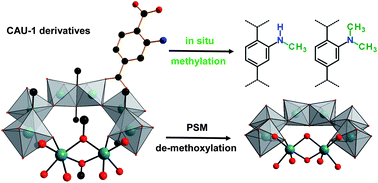
CrystEngComm, 2012,14, 4126-4136
https://doi.org/10.1039/C2CE06620C
Thermal post-synthetic modification of Al-MIL-53–COOH: systematic investigation of the decarboxylation and condensation reaction
The pore surface chemistry and composition of Al-MIL-53 with pendant –COOH groups are modified by thermal treatment during the activation process.
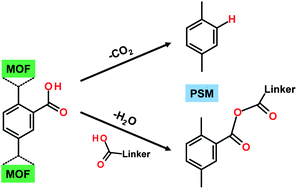
CrystEngComm, 2012,14, 4119-4125
https://doi.org/10.1039/C2CE06649A
About this collection
This first CrystEngComm Collection brings together a series of papers concerning recent developments in the postsynthetic modification of coordination networks.